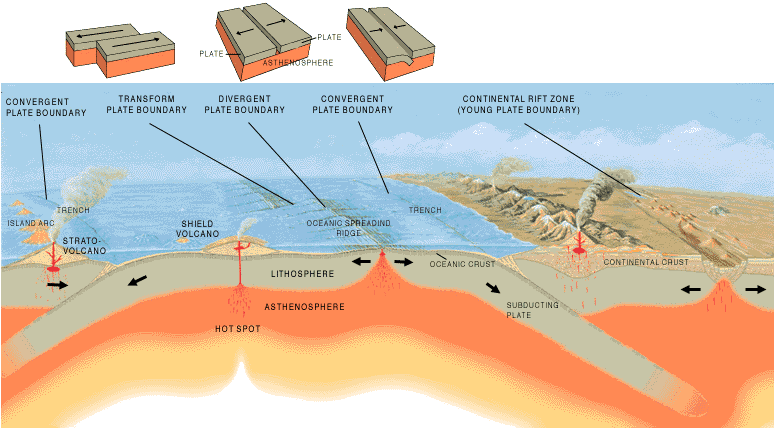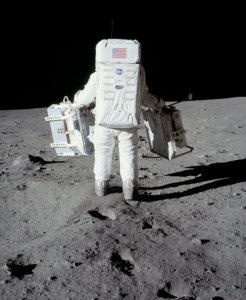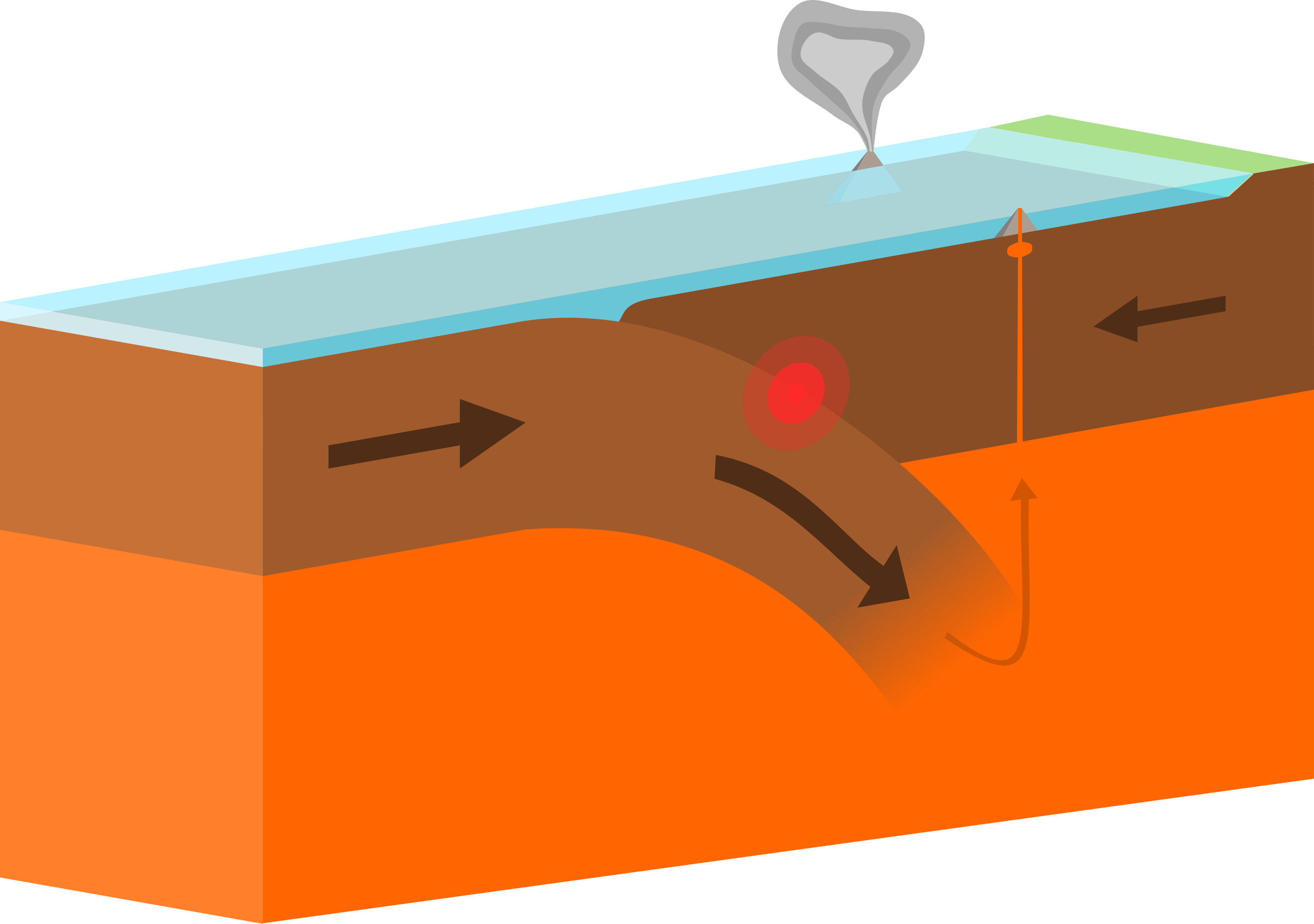2.4 Convergent Boundaries
Charlene Estrada
Across our Earth, different plates collide with one another, move past one another, and pull away from one another. These movements between plates result in a wide variety of different plate boundaries, amazing landscapes, and dangerous hazards. Very broadly, plate interaction can be placed in one of three categories. Below, we will explore the first of these: convergent boundaries.

Convergent boundaries are places where two or more tectonic plates move toward each other. The process of convergence relies on compressional stress, which squeezes or pushes the two tectonic plates together. Convergent boundaries, more than any other, are known for building mountain chains. It is because tectonic plates collide with one another that Earth has seen periods of supercontinent formation, in which the continents as we know them today were once merged together into one landmass. The ancient continent of Pangaea is a well-known example of a supercontinent that once existed over 250 million years ago!
The key to predicting what will happen at a convergent boundary is understanding the density of each plate involved in the movement. You may tend to think of density, mass, and weight as all being similar. Whereas weight is the heaviness of an object relative to the planet’s gravitational field, mass is the amount of matter that object contains. Density is different; it is a measure of how tightly packed matter is within a given volume of a material, and it is usually measured in units of “mass per volume”.
Digging Deeper: Weight, Mass, and Density
We just read through a verbal description of weight, mass, and density, but what do they really mean? Notice that the description of weight is “relative to a planet’s gravitational field”. Earth is the only home we know, so we are a bit biased in assuming weight and mass tend to be the same thing in our daily lives, but that wouldn’t be helpful for an astronaut walking on the Moon!

Example: Astronaut Buzz Aldrin takes his first step on the Moon! A spacesuit tends to weigh a whopping 280 lbs, plus let’s assume Buzz was about 150 lbs at the time for a total weight of 430 lbs on Earth. The Moon’s gravity is only one-sixth of the Earth’s! So how much does Buzz weigh on the Moon?
430 lbs / 6 = 71.7 lbs No wonder Buzz is feeling light!
However, Buzz’s mass on Earth with the spacesuit is about 195 kg. This remains the same on the Moon, in space, and wherever he may go – he just may experience “heaviness” differently in those places!
Let’s assume the volume of Buzz with the spacesuit on is roughly 90 L, or 90,000 cm3. The density of our astronaut (in grams/cm3) is:
Density = 195,000 g / 90,000 cm3 = 2.2 g/cm3
That is pretty dense. Humans without spacesuits are mostly water, and that’s a density of around 1 g/cm3 for comparison.
How does density affect plate motions at convergent boundaries? View the different types of plate collisions below to find out!
Oceanic-Continental Convergent Boundary

Oceanic-continental convergent boundaries occur when a tectonic plate primarily composed of oceanic lithosphere collides with a plate with continental lithosphere. As mentioned in a previous chapter, oceanic lithosphere, or crust, contains more iron- and magnesium-rich minerals, and it is therefore denser than continental lithosphere. When these very different plates converge, the plate with oceanic lithosphere will buckle beneath the continental plate, and sink into the hot asthenosphere. This process is called subduction [14].
When the subducting plate, which is also known as a slab, is subjected to the high temperatures of the asthenosphere, surface materials that were trapped in its rocks, such as hydrated minerals, undergo alteration and water vapor escapes. That water vapor lowers the melting temperature of the surrounding rock, and it produces magma. The magma rises and forms volcanic arcs in the mountains along the overlying continental crust.
Video 2.4.1. The convergence between oceanic and continental crust in a subduction zone produces a volcanic arc on the continental plate. Identify the processes occurring in this short animation (0:11).
What Happens to the Subducting Slab?
As the dense oceanic lithosphere begins to subduct down into the mantle, it continues this journey at an average rate of 25 miles per million years, or a half inch per year. This slab also pulls the neighboring ocean floor down into a trench. On average, the ocean floor is around 3-4 km deep. In trenches, the ocean can be more than twice as deep, with the Mariana Trench approaching a staggering 11 km!
Over tens of millions of years, the descending slab will eventually be destroyed in the Earth’s internal heat, although in some cases it will journey far into the mesophere in the lower mantle before this occurs. Today geophysicists image our mantle to find the remains of ancient slabs that were once part of Earth’s surface. All of this is proof that plate tectonics has been operating for billions of years, and it has enabled the Earth to become an efficient recycler!
PLATE TECTONICS IN ACTION: Oceanic-Continental Convergent Boundaries
The landscapes resulting from oceanic-continental convergent boundaries are all around us! Some well-known examples of this type of convergent plate boundary on our planet include:
- The Cascades (Western North America)
- The Andes: (Western South America)
Oceanic-Oceanic Convergent Boundary

An oceanic-oceanic convergent boundary describes a collision between two plates composed of oceanic lithosphere. Even though this boundary involves the same type of lithosphere, one of the plates will still subduct beneath the other. Oceanic lithosphere is notoriously dense; in some cases it is even denser than the asthenosphere, which means it never has trouble sinking into the mantle once the subduction process begins!
When two plates made of oceanic lithosphere meet, how can we predict which of the two will subduct? It almost always depends on age. With increasing age, the oceanic lithosphere becomes colder and denser. The oceanic lithosphere becomes systematically older as it moves away from the spreading centers at mid-ocean ridges, as you can see in the heat map below:

All of this means that the older, denser, and colder plate at an oceanic-oceanic convergent boundary will always subduct into the mantle!
Video 2.4.2. Short animation of a convergent boundary between two oceanic crusts. Observe the volcanic island arc. What is different and similar between this video and the previous one? (0:15)
PLATE TECTONICS IN ACTION: Oceanic-Oceanic Convergent Boundaries
The features at or resulting from oceanic-oceanic convergent boundaries are pretty well known! Some notable examples of this type of convergent plate boundary on our planet include:
Continental-Continental Convergent Boundary

A continental-continental convergent boundary describes the collision of two tectonic plates composed of continental lithosphere. Just like an oceanic-oceanic convergent boundary, this type of boundary involves the compression of the same type of lithosphere. However, there is one key difference; subduction never takes place at these boundaries.
The continental lithosphere is not very dense. In fact, compared to the underlying asthenosphere it is buoyant! This means that if a force were to push continental lithosphere down into the mantle, the low-density lithosphere would push itself back up like a cork in a glass of water.
What happens at these convergent boundaries? Any underlying, dense oceanic lithosphere attached to the plate might sink, but the two plates of continental lithosphere will collide with one another. Within these collision zones, the lithosphere will deform, thicken, and events of extreme mountain-building will occur. Some of our most famous mountain ranges have been formed as a result of continental-continental convergence! For example, watch the Himalayan mountain range (which contains Mt. Everest) form in the video below (0:39 to end).
Video 2.4.3. Animation of paleogeography showing the evolution of the continents over time (0:56).
Because the continental lithosphere never subducts, very little of it is destroyed in the mantle. Although continental crust can slowly become weathered down and eroded away by Earth’s atmosphere and hydrosphere, some of it has persisted for billions of years! As a result, geoscientists can piece together the early history of our planet using clues from rocks on our continents.
PLATE TECTONICS IN ACTION: Continental-Continental Convergent Boundaries
There are some famous mountain ranges that have formed as a result of Continental-Continental convergent boundaries! These include:
- The Himalayas (India, China, Tibet)
- The Alps (France, Switzerland, Italy, Austria, Slovenia)
- Zagros (Iran, Iraq, Syria, Turkey)
- The Appalachians (The United States)
Something important to keep in mind is that Continental-Continental convergent boundaries do not “just” form! When the plates first collide, at least one of them typically contains oceanic crust. This is because over 70% of our planet’s surface is covered by oceanic lithosphere. As a result, the convergent boundary will first form a subduction zone, but after all the oceanic lithosphere has finished subducting, the boundary becomes Continental-Continental. This is how supercontinents form!
Video 2.4.4. This short animation shows what happens when two continental crust collide. Compare and contrast this video with the two before (0:22).
A region along Earth's lithosphere where at least two tectonic plates collide with one another.
A type of force placed on an area of rock that presses or squeezes it tighter together.
a massive landmass composed of multiple continents formed by the collision of tectonic plates with smaller continents.
also known as Pangea. A large, single landmass, or supercontinent, that existed on Earth from about 300 - 180 million years ago.
The measure of how tightly packed atoms are in an object or material in a given volume. It is determined by figuring out its mass, divided by its volume.
The relative "heaviness" of an object relative to its planet's gravitational field. Your weight will change on other planets.
A measure of the amount of matter, or atoms, that a given object or material with finite boundaries contains. Your mass will not change from planet to planet.
The outer, relatively rigid layer of the Earth that is composed of crust and upper mantle.
A type of rigid, thin crust made of iron and magnesium rich minerals that is found beneath the planet's oceans.
A ductile but solid, hot layer in the Earth composed of the lower crust and upper mantle that flows like putty over long periods of time. It drives the movement of the rigid tectonic plates riding above.
The process in which the older, denser tectonic plate at a convergent boundary will buckle and sink into the lithosphere. This plate will always be composed of oceanic lithosphere.
The tectonic plate descending within a subduction zone into the asthenosphere, and beyond toward the deep mantle.
molten rock that can be found beneath the Earth's surface.
a chain of volcanoes that forms above a subducting plate at a convergent boundary. A volcanic arc may be associated with an island chain or a mountain ridge.
a narrow, deep depression in the seafloor that forms when a tectonic plate subducts at a convergent boundary. These features can extend as deep as 11 km deep.
The physical layer in the Earth's mantle that lies between the asthenosphere and the core.
The deeper of the two mantle layers in Earth's interior, also called the mesophere. The lower mantle is hotter and more rigid than the upper mantle.
A hot interior layer of solid rock between the crust and core that is capable of plastic flow. The mantle is the largest layer of Earth.
The theory that the outer layer of the Earth (the lithosphere) is broken in several plates, and these plates move relative to one another, causing the major topographic features of Earth (e.g. mountains, oceans) and most earthquakes and volcanoes.
when one tectonic plate slides beneath another
The process of physically or chemically breaking down, transforming, or dissolving existing rock with contact by water, the atmosphere, or biosphere.
The process of physically transporting soil, sediment, and rock fragments to a different location.

